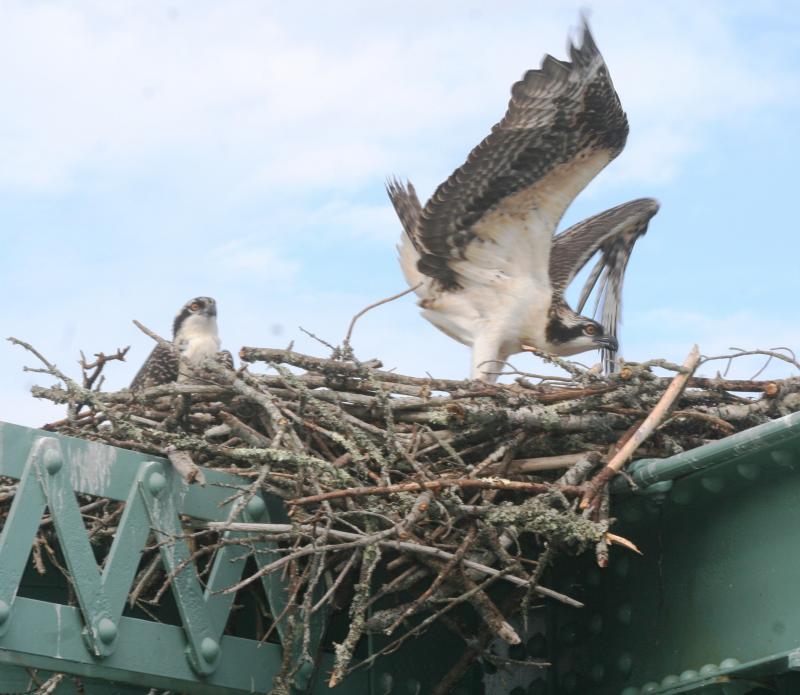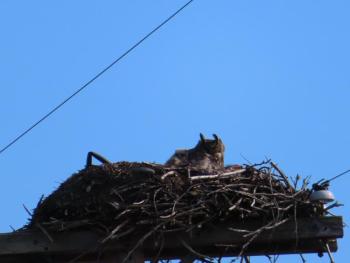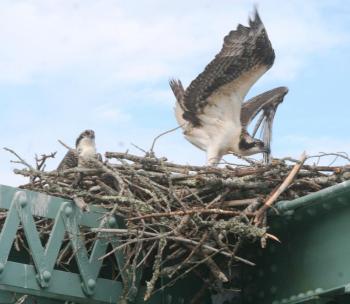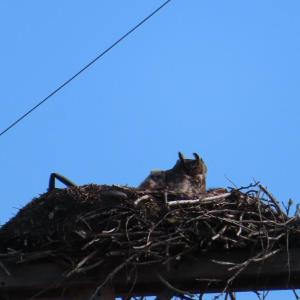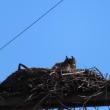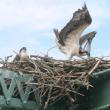A Big Nest Surprise
Ospreys are big birds. They make big nests that very often sit out in the open so that the birds on the nest are visible to all. Brother Andrew and his spouse Nina have one of these osprey nests near their house. They have watched a pair of osprey raise young each summer from that nest for many years.
So they were perplexed in April when they saw ospreys in the area that had returned from their winter haunts, yet none had settled in to use the nest, which appeared to be in perfect condition. After some time without any ospreys on the nest, they and their neighbors began noticing a head with two ear tufts sticking up from the nest.
There on the nest was a great horned owl! Despite the fact that the nest was in a most obvious location, the bird had apparently been sitting on eggs there since well before the ospreys had returned in spring migration. Great horned owls are famous for starting their nesting season as early as February even here in Maine, despite the frigid temperatures. These birds had been incubating eggs through March and, by April, probably feeding nestlings in this conspicuous nest but had escaped detection by the nearby humans, at least until late April, when the current occupants returned.
Yes, ospreys are big birds, they are smart enough not to tangle with a great horned owl—especially one with young in the nest. Great horned owls are sometimes called the “tigers of the air” because they are tenacious and deadly predators known to kill a wide range of mammals and birds that are too big to be preyed on by much else. Andrew and Nina reported that the ospreys gave them all the space they wanted.
Meanwhile, the owls, once they became known to the neighborhood, became a curiosity that could be observed from the road at a distance that ensured they were not disturbed. Much to the delight of the human observers, soon at least one small owlet could be seen peeking its head out from under the wing of the parent.
We note in reading the great horned owl account in “Birds of Maine” that great horned owls have been found nesting in osprey nests at least twice before in Maine, including once in Woolwich.
Andrew and Nina report that the owls were not seen on the nest anymore after mid-May, which makes sense as that is the normal time for young owls to fledge. They typically don’t go far; a thorough scan of trees nearby the nest from where they fledged sometimes reveals the young birds roosting. The young owls are still dependent on the adults to provide food throughout the summer and can often be heard making screechy begging sounds in the night as they wait for the adults to bring something to eat.
To make the story even more amazing, the osprey pair began reoccupying the nest just days after the young owls fledged. As of today, they are sitting on eggs again. Imagine the same nest being used by two different bird species to raise young in the same year!
Jeffrey V. Wells, Ph.D., is a Fellow of the Cornell Lab of Ornithology and Vice President of Boreal Conservation for National Audubon. Dr. Wells is one of the nation's leading bird experts and conservation biologists and author of the “Birder’s Conservation Handbook.” His grandfather, the late John Chase, was a columnist for the Boothbay Register for many years. Allison Childs Wells, formerly of the Cornell Lab of Ornithology, is a senior director at the Natural Resources Council of Maine, a nonprofit membership organization working statewide to protect the nature of Maine. Both are widely published natural history writers and are the authors of the popular books, “Maine’s Favorite Birds” (Tilbury House) and “Birds of Aruba, Bonaire, and Curaçao: A Site and Field Guide,” (Cornell University Press).
Event Date
Address
United States


